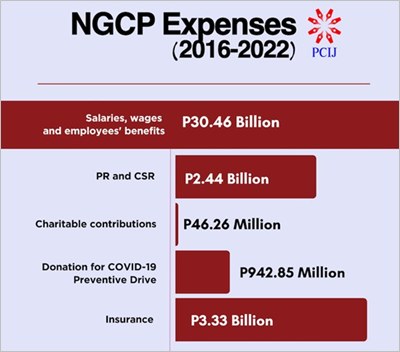Power grid operator
NGCP billed P2.4B worth of CSR, PR expenses to consumers

Since January 2023, the Energy Regulatory
Commission has held 14 hearings to determine how much the NGCP
should charge customers. The result of the investigation could mean
refunds or higher electricity bills in the coming years.
By
ELYSSA LOPEZ
Philippine Center for Investigative Journalism
November 7, 2023
MANILA – As the sole public utility
in charge of power transmission lines, the chief mandate of the
National Grid Corporation of the Philippines (NGCP) is to ensure the
reliability of the country’s electricity. So when a government
representative found that the company had included corporate social
responsibility (CSR) activities as part of its operating expenses,
she sought an explanation.
“Are CSR expenses necessary for the provision of the transmission
services by NGCP?” asked Marbeth Laconico, corporate secretary of
the National Transmission Corporation (TransCo), during a hearing
called by regulators.
Transco is the state entity that owns the power transmission grid,
which brings power supply from generating plants to electricity
distributors. NGCP, owned by a consortium of Filipino tycoons and
the State Grid Corporation of China, won the concession deal to
operate it after a public bidding in 2007.
Questions over the NGCP’s finances have grown in recent years, as
the transmission operator, a state-sanctioned monopoly, reported
higher profitability. Last year, NGCP reported P34.7 billion in net
income on nearly P62 billion in revenues. Net profit margin grew to
56.15% from 47.6% year-on-year.
Yet based on its financial statements from 2016 to 2022, NGCP passed
on to consumers P2.4 billion in expenses for “public relations and
corporate social responsibility,” P46.2 million in “charitable
donations,” and a donation of P942 million for a “COVID-19
Preventive Drive.”
“NGCP values not only the quality of [its] transmission service. We
also like to put [a] premium [on] engaging with communities, which I
suppose all companies are undertaking as part of their corporate
social responsibility projects,” Raymund Fontillas, financial
controller of NGCP, told regulators.
Regulators have also sought explanations for the huge amount spent
by the grid operator on salaries and benefits paid to employees, as
well as expenses due to force majeure such as natural calamities.
Since January 2023, the Energy Regulatory Commission (ERC) has held
14 hearings to determine how much the NGCP should charge customers
for the period 2016 to 2022, the fourth round of regulatory reviews.
TransCo and distribution utilities like Meralco grilled the NGCP
during the hearings, where the exchange between TransCo’s Laconico
and NGCP’s Fontillas happened.
Transmission rates are supposed to be set every five years, the
length of a regulatory period. But that has not happened in the past
decade. The last time the NGCP had a regulatory review was in 2010,
which determined the maximum allowable revenue it could earn for
2010 to 2015, the company’s third regulatory period.
The ERC did not call for a formal review of the rates until it
issued the Amended Rules for Setting Transmission Wheeling Rates (RTWR)
in 2022, which officially began the fourth regulatory review.
It does not mean the NGCP has stopped collecting fees from
customers, however. The company has maintained an average net profit
margin of 47.83% from 2016 to 2022. Based on its financial
statements, the company earned an average of P23 billion annually
during the five-year period.
This delay had been the subject of multiple Senate and House
hearings, on top of NGCP’s own delay in the construction of its
interconnection projects that add to consumers' monthly electricity
payments.
At least 9% of what Filipinos pay for electricity goes to
transmission charges. This means that for every P100 spent on the
electricity bill, P9 goes to the NGCP.
How much that 9% costs monthly is determined by the ERC, the
quasi-judicial body in charge of regulating the energy sector.
Insurance bought from shareholder’s firm
The regulatory review hearings provided a venue for the NGCP to
explain the expenses that had been questioned multiple times by
critics.

Among other expenses questioned during the hearings were force
majeure events (FMEs). For the fourth regulatory period, the NGCP is
applying for P1.057 billion worth of FME claims, including related
costs that occurred after 2010 or before the fourth regulatory
period.
Such expenses can be passed on to consumers, subject to the approval
of ERC. Natural disasters such as typhoons, earthquakes, and
landslides, or man-made disasters such as war or riots, are
considered as FMEs.
Under the concession agreement between the NGCP and TransCo, the
former is mandated to insure its assets. NGCP’s financial statements
showed the company spent P2.8 billion in insurance payments from
2018 to 2021, which include industrial all-risk insurance, a type of
policy that allows the policyholder to protect assets from risks
other than fire.
Almost half of insurance policies during the period, or about P1.3
billion, were procured from Prudential Guarantee and Assurance Inc,
one of the country’s largest non-life insurers. Its chairman, Robert
Coyiuto Jr., owns one of the shareholders of NGCP: Calaca High Power
Corp.
Reeva Shane Viado, corporate financial analyst of the Power Sector
Assets and Liabilities Management Corp. (PSALM), the state entity
that restructured the energy sector, sought clarification during the
hearing from NGCP if it had claimed any amount related to FMEs from
its insurance providers.
“It is just our position… that if NGCP has already recovered any
amount from its insurance providers, such amount should not be
included in this revenue under the recovery proposal of NGCP,” Viado
said.
The NGCP representative failed to respond to the question.
The ERC also posed “clarificatory questions” regarding the
compensation package of NGCP employees. In August, the commission
asked NGCP to provide a detailed breakdown and explanation of
salaries, wages, and employee benefits from 2016 to 2020.
Salaries and employee benefits, which totaled P20.9 billion from
2016 to 2020, were the second biggest expense item during the review
period.
Public records showed the NGCP employs about 4,700 employees. That
means each employee earned P4.4 million a year on average, or about
P371,000 a month.
Financial statements also revealed that key management personnel had
enjoyed “short-term benefits” that averaged P346 million from 2016
to 2020. The documents however were silent on what kind of benefits
were paid to these employees.
Fourth regulatory review
With the delay in its regulatory review, the NGCP has been billing
customers based on 2010 rates. A paper by University of the
Philippines economics professor Joel Yu found that the company
“continues to enjoy the rates of return determined by the ERC which
are no longer reflective of the opportunity cost of capital.”
As the rates were determined based on prevailing market conditions
–
just after a financial crisis – a premium was placed on the risk
taken by the NGCP in operating the country’s transmission grid. The
economy has since recovered.
The ERC uses a performance-based review in determining the NGCP’s
wheeling rates. This means the company may obtain cash incentives in
case it performs beyond the target criteria set by the commission.
These criteria are supposed to be reviewed every regulatory period.
Because of delays in the review, the NGCP was allowed to recover an
interim maximum annual revenue from 2016 to 2020 based on criteria
set in 2010. In the ongoing review, the NGCP claimed that customers
owed it P316 billion, or the total revenue requirement from 2016 to
2020.
Based on PCIJ’s analysis of available data, that amount was at least
28% higher than what the NGCP had charged customers during the
review period.
ERC asked the NGCP during the hearings how much the revenue
requirement would translate to per-kilowatt-hour rates, but the grid
operator was unable to reply.
The ERC has decided to catch up on the delay and extend the duration
of the fourth regulatory period, 2016 to 2020, up to 2022, or from
five years to seven years.
The NGCP opposed this, citing the five-year intervals followed in
previous regulatory periods. In October, the ERC denied the plea,
which means the decision on the fourth regulatory review is set to
be published soon.
How the ERC decides on which expenses the NGCP can pass on to
consumers will result in either refunds or higher electricity bills
in the coming years.